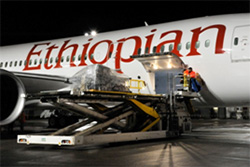While some of these aid missions are led by inter-governmental bodies, such as the UN, in many other cases, the industry itself takes on the responsibility of helping where it can. One such example of the industry taking a leading role in humanitarian work is a recent collaboration between Boeing, Ethiopian Airlines and three non-profit organisations (Vital Voices Global Partnership, Horn of Africa Neonatal Development Services and Seattle Alliance Outreach).
 These partners have joined together to bring more than 4,000 pounds (1,814 kilograms) of medical supplies and equipment to charities and hospitals in Ethiopia and Somalia. The equipment being delivered includes an autoclave to sterilize surgery equipment which will be used by a new kidney dialysis center in Ethiopia, as well as neonatal medical equipment for Jimma University, College of Public Health & Health Sciences, which will be used exclusively to treat infants.
These partners have joined together to bring more than 4,000 pounds (1,814 kilograms) of medical supplies and equipment to charities and hospitals in Ethiopia and Somalia. The equipment being delivered includes an autoclave to sterilize surgery equipment which will be used by a new kidney dialysis center in Ethiopia, as well as neonatal medical equipment for Jimma University, College of Public Health & Health Sciences, which will be used exclusively to treat infants.
Ethiopian Airlines see themselves as having a corporate responsibility to help whenever possible in the region, making them a perfect partner in Boeing’s Global Corporate Citizenship's Humanitarian Delivery Flights program, which has since 1992 facilitated more than 170 humanitarian delivery flights worldwide. Initiatives like this ensure that aviation’s unique ability to reach remote areas quickly and safely is properly utilized for the benefit of those in need throughout the world.

